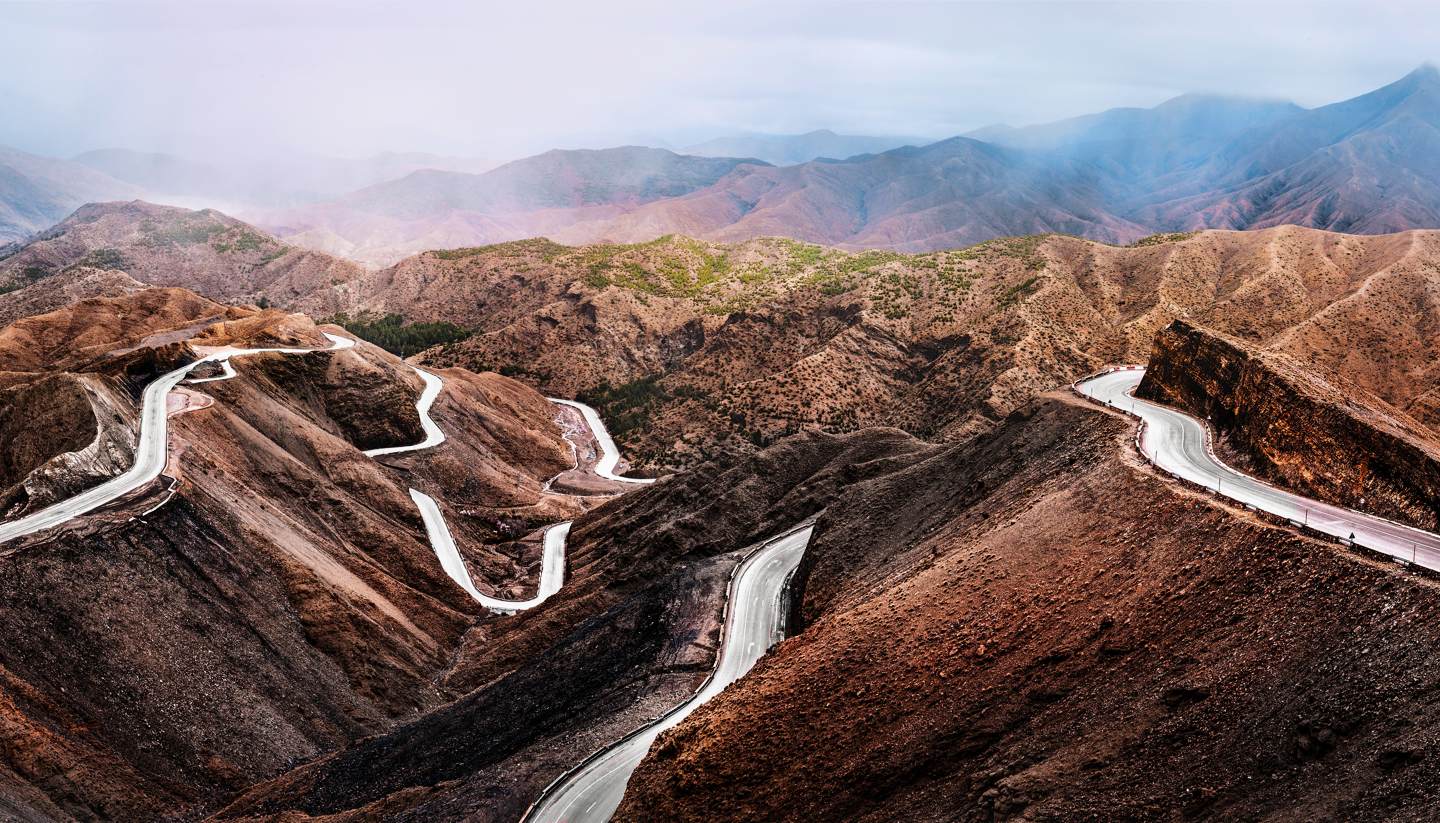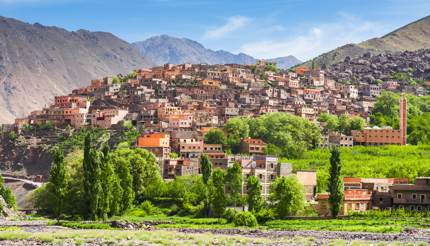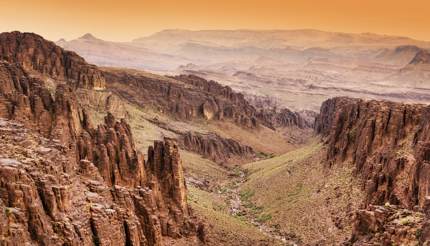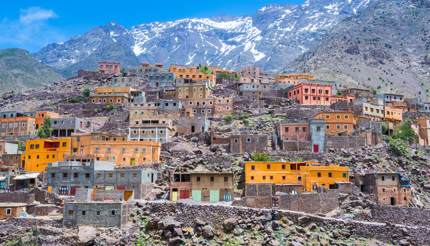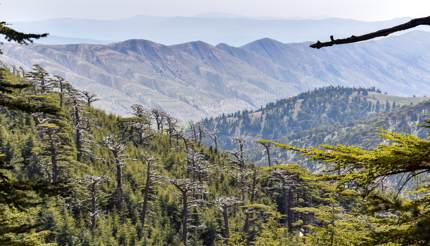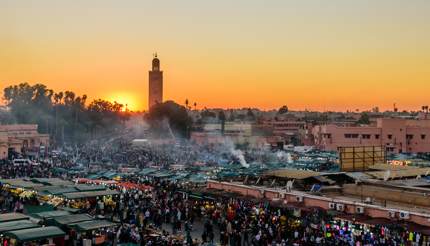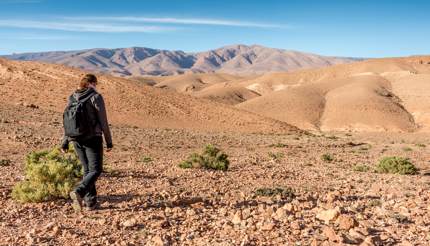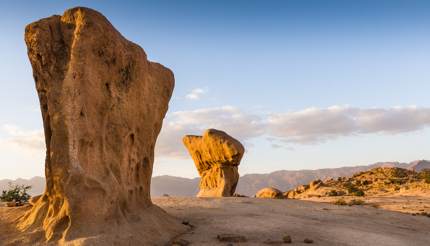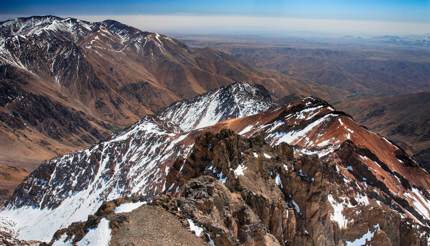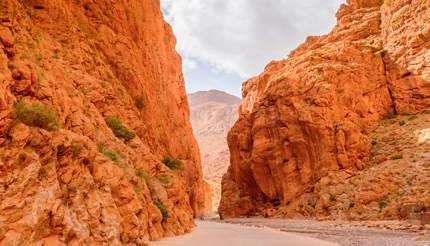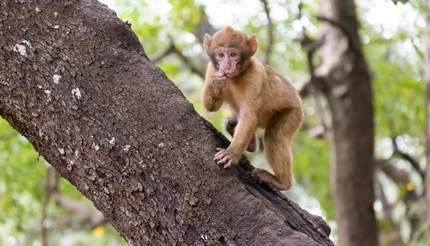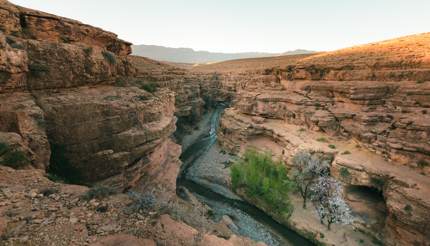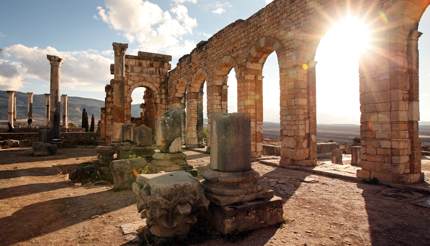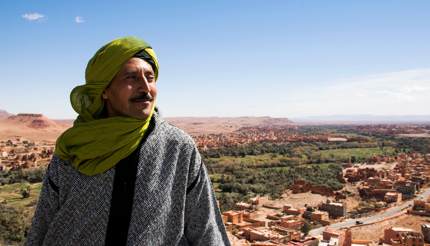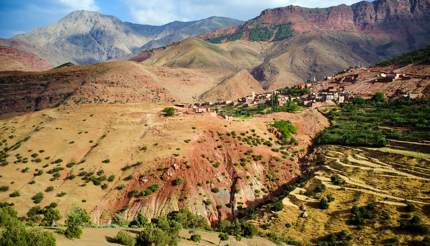The Atlas Mountains offer diverse scenery and here is what you need to know before visiting the Anti-Atlas, High Atlas and Middle Atlas sub-ranges
NASA (National Aeronautics and Space Administration) has an absolutely beautiful image of the Atlas Mountains taken from space. It is an ASTER (Advanced Spaceborne Thermal Emission and Reflection Radiometer) image, showing shades of red, green and blue representing combined short-wavelength infrared bands and highlighting different rock types like limestones, sandstones, gypsum and granitic rocks. The picture is likely to leave you in awe.
On land, if you were to make your way to a Barber community near Aroumd within the Assif Aït Mizane Valley, part of the High Atlas Mountains, the gorgeous views of soaring mountains, sunken valleys and bright green terraced fields would probably leave you in awe too.
Suffice to say, the Atlas Mountains are one of the world’s most fascinating regions to travel through. Most people come here to trek, walking from one remote village to another. If this is what you intend to do, then let this guide share everything you need to know in preparation for a journey to this stunning region.
What are the Atlas Mountains?
Stretching some 2,500km (1,600 miles) across Morocco, Algeria and Tunisia, the mighty Atlas Mountains are a series of mountain ranges created by the violent collision of the African and Eurasian tectonic plates roughly 80 million years ago.
The Atlas Mountains can be split into six distinct sub-ranges:
Anti-Atlas range, aka Lesser Atlas or Little Atlas, extending from the Atlantic Ocean in the southwest of Morocco to Tafilalt, the largest oasis in Morocco. The contrasting landscapes are otherworldly.
High Atlas or the Grand Atlas Mountains are probably the most well-known section of the Atlas Mountains. The area stretches from the Atlantic coast to the Moroccan-Algerian border and includes Toubkal, the highest summit in North Africa at 4,167m or 13,671ft.
Middle Atlas is the northernmost chain of the Atlas Mountains. It is also in Morocco.
Saharan Atlas marks the northern edge of the Sahara Desert. It is mainly in Algeria with a small area extending to the eastern side of Tunisia.
Tell Atlas is vast, covering Morocco, Algeria and Tunisia. It runs parallel to the Mediterranean coast and acts as a weather system barrier that separates the Mediterranean climate to the north and the Saharan climate to the south.
Aurès Mountains in Algeria and Tunisia make up the eastern part of the Atlas Mountains.
How far are the Atlas Mountains from the major cities?
It is possible to experience part of the Atlas Mountains via day trips or two-day trips from major cities across the three countries.
Marrakech is undoubtedly the best hub if you want to explore the Atlas Mountains. The ‘Red City’ is an intoxicating place that remains universally popular as a tourist destination. Marrakech also sits on the cusp of the High Atlas – the most popular sub-range of the Atlas Mountains. As such, Marrakech is the perfect launching pad for a journey into the Atlas Mountains thanks to being two hours’ drive from the High Atlas gateway town of Imlil.
Fès (or Fez) and Meknes to the north act as great entry points into the Middle Atlas, while Agadir is closer to the Anti-Atlas.
In Algeria, Constantine is relatively close-by to both the Tell Atlas and the Aurès Mountain sub-ranges. Both Algiers and Oran, the two largest cities in Algeria, are gateways into the Tell Atlas sub-range.
The Atlas Mountains range ends at Tunis, making the capital of Tunisia a great setting-out point for those who are looking to conquer the whole range (with Agadir acting as the most westerly point).
What can you do in the Atlas Mountains?
The Atlas Mountains are a terrific location for trekkers who want to take in different sights. Nature is the true attraction here. You will find remote valleys, windswept canyons and mighty peaks that offer jaw-dropping views. During spring (March to May) and autumn (September to November), you will meet fellow walkers from around the world coming to savour a ‘back-to-basic’ experience that is devoid of modernity.
Embracing the local Berber culture is an absolute must. The locals are friendly and welcoming – it is easy to find yourself invited for some tea. The Berber communities in Morocco are mainly farmers, livestock owners, and also merchants. They also make good tour guides to foreign visitors.
In this guide, we will focus on the key sights in the Anti-Atlas, High Atlas, and Middle-Atlas sub-ranges, all of which are in Morocco.
What are the sights in the Anti-Atlas sub-range?
Tafraoute (Tafraout), 166km (103 miles) southeast of Agadir, is famed for blue painted rocks by artist Jean Verame and strange rock formations revealing the powerful force of nature. Another highlight is megalithic art of cattle and Berber warriors near Tazka, which is within walking distance from Tafraoute.
On the road from Agadir to Tafraoute, you will pass by Tagdicht and undoubtedly will notice the imposing Jebel El Kest (Afa-n-Tmezgadiwine), the highest point in this area at 2,359m (7,740 ft). You can hike from Tagdicht to Jebel El Kest in four hours. If you visit in spring, you will see find flowering grey-leaved cistus (Cistus albidus) in abundance.
What are the sights in the High Atlas?
Imlil, 90km (56 miles) south of Marrakech is where most visitors start their journey into the High Atlas. Set outside the Toubkal National Park (Parc National du Jbel Toubkal), Imlil is a hub for mountain tourism in Morocco – meaning it is the place to meet your guide, hire a mule or get any last-minute supplies before starting your trek. The route from Imlil to Refuge du Toubkal (French CAF Refuge) – the second hut – should take about four hours, although you are likely to take some time admiring the stunning views around Aroumd which is along the way.
It is recommended that you stay in Refuge du Toubkal for a day to get acclimatised, before conquering the summit of Jbel Toubkal which can be done in four hours from Refuge du Toubkal.
Following the murder of two tourists in December 2018, the authority now requires each group to be accompanied by a qualified local guide who has plenty of experience and knowledge regarding the High Atlas before attempting ascent. You must also book accommodation in advance and camping in unauthorised places is prohibited.
Azzaden Valley, just south of Imlil, is often touted as the quieter alternative to Imlil. It is possible to walk from Imlil to Azzaden Valley (about six hours). You can also start the hike to the summit of Jbel Toubkal from here.
Ourika Valley, 40km (25 miles) southeast of Marrakech, is also popular with day-trippers from Marrakech. This verdant corner of the High Atlas Mountains is best visited on Monday when the local souk (Tnine Ourika) takes place and the town comes alive. If you join a tour, you are likely to visit a women’s argan oil co-operative and have tea with a Barber family in Setti Fatma.
From Ourika, if you travel north and then southeast for four hours, you will come to the UNESCO-listed Ksar of Aït Ben-Haddou. Lying in the Ounila Valley on the southern slopes of the High Atlas, Ait Ben-Haddou is a must-see destination for movie buffs as it was featured in The Mummy, Gladiator, Alexander and even Game of Thrones. The buildings, made of clay bricks, date back to the 1700s.
Todgha Gorge, near the town of Tinghir (Tinerhir) some 390km (242 miles) east of Marrakech, is breathtakingly beautiful and a magnet for photographers, hikers and rock climbers.
What are the sights in the Middle Atlas sub-range?
The oak and cedar-forested Ifrane National Park lies 80k (50 miles) south of Fès, it is home to the world’s largest population of Barbary macaques. Seeing a troop of them – with 10 to 30 individuals in a troop – is almost guaranteed. In the Cedre Gouraud Forest, there is also an 800-year-old cedar tree.
Berrem Gorge (Gorges des Berrem) is a small but stunning canyon near the market town of Midelt, 199km (124 miles) south of Fès. In the surrounding areas, there are plantations producing walnuts, plums, apricots and pomegranates.
Once a base of the Roman Empire, Volubilis is now a UNESCO World Heritage Site dotted with Roman ruins – it is quite sensational to see remnants of the Arch of Caracalla, Basilica, and Capitoline Temple rising from the plain. The distance between Fès and Volubilis is 69km (43 miles), so give or take 1 hour 30 minutes.
What should you pack?
If you plan to trek in either spring or autumn, pack mountain boots and sneakers (you don’t want to wear your boots after a long day of walking), waterproof clothing, a warm layer, water bottle, binoculars, sun hat, sunscreen, insect repellent and hand sanitizer. Do not pack wet wipes because they contain plastic fibres that do not break down easily.
The water quality in Morocco has improved. If you are staying in hotels and filling up your water bottles every morning, then chances are, you should be alright. But if you have a sensitive stomach, pack some water purification tablets.
Consider relying on local knowledge by hiring a Berber guide. Many of these guides are incredibly fit and well adapted to the various routes and intricacies of the Atlas Mountains range.
You can also hire a mule – mules are known as the Berber Mercedes; they can carry your bags across the rough terrain for an additional price.
Keen photographers may want to consider travelling in a guided tour using a 4×4. It is possible to find photography experts with local knowledge who will be able to show you the most photogenic areas across the various sub-ranges.
In the winter, the warmth dissipates and the peaks are capped with snow – so pack warm jackets, gloves, woollen socks, and a beanie.
What will you eat?
When it comes to food, expect traditional fair like fresh bread, couscous and tagines, as well as bean-based soup. Snacks like dates and figs are also popular.
Chicken and olive tagine, as well as lamb tagine cooked with a variety of dried fruit, featured heavily on the menu. You eat them with bread and couscous.
If you are invited to a festival, chances are you will come across Mechaoui, a whole roasted lamb which is best enjoyed with the entire community.
Best time to visit the Atlas Mountains
Although the area is vast, covering some 2,500km (1,600 miles), March to May (spring) and September to November (autumn) are considered the best times to visit the Atlas Mountains if your primary purpose is hiking. During peak periods, prices tend to be higher and tourist sites are likely to be crowded.
Summer is sizzling hot at most of the sights we covered above, while winter can be rainy, or snowy, depending on where you go. For example, you can ski in Toubkal National Park and Oukaïmeden from January to March.
Ramadan is a special time where Muslims will pray, reflect spiritually and reach out to family and friends. It is also a month of fasting. You should avoid visiting the Atlas Mountains during Ramadan as shops are likely to shut or have shorter hours.
This was initially published in 2014 and was updated on 08/10/2019.
Before you go, check out the Morocco Travel Guide.
If you found this interesting, check out:
